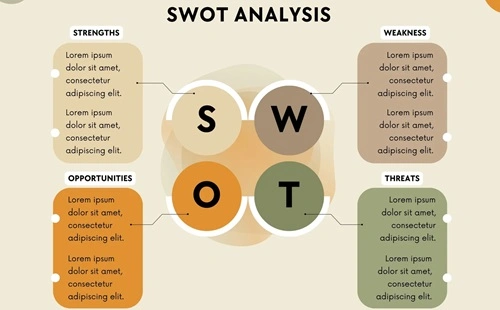SWOT analysis, a strategic planning tool, has been instrumental in helping businesses assess their position in the market. By examining Strengths, Weaknesses, Opportunities, and Threats, organizations can make informed decisions. However, like any tool, SWOT analysis has its pros and cons. This article explore the advantages and disadvantages of SWOT analysis in 2025, integrating the latest industry practices and trends.
Advantages of SWOT Analysis
1. Holistic View of the Business
- SWOT analysis offers a 360-degree perspective by assessing internal (Strengths and Weaknesses) and external (Opportunities and Threats) factors.
- In 2025, with complex market dynamics such as digital disruption and sustainability pressures, businesses benefit from a comprehensive evaluation tool like SWOT.
2. Simplicity and Accessibility
- The methodology is straightforward and does not require specialized skills or tools, making it accessible for small businesses and startups.
- Tools like AI-enhanced SWOT analysis platforms simplify data collection and processing, further democratizing its use.
3. Strategic Planning Support
- SWOT analysis identifies critical areas for growth and improvement, enabling businesses to align their strategies with market realities.
- For instance, companies leveraging data from SWOT analysis can prioritize investment in emerging markets or technology.
4. Risk Mitigation
- By identifying threats early, businesses can develop contingency plans.
- In the context of 2025, where supply chain disruptions and geopolitical tensions are prevalent, SWOT analysis aids in proactive risk management.
5. Enhances Decision-Making
- SWOT analysis provides actionable insights, facilitating better decision-making across departments.
- For example, a company might use SWOT findings to decide whether to expand geographically or invest in product innovation.
6. Versatility Across Industries
- From FMCG to tech startups, SWOT analysis is adaptable to various sectors.
- In 2025, industries like renewable energy and fintech use SWOT analysis to navigate challenges such as regulatory changes and technological evolution.
7. Cost-Effective
- Unlike advanced analytical tools, SWOT analysis requires minimal financial resources, making it an economical choice for businesses of all sizes.

Disadvantages of SWOT Analysis
- Lack of Quantitative Analysis
- SWOT analysis is qualitative, which may lead to subjective interpretations.
- In 2025, businesses often complement SWOT with data-driven tools like business intelligence (BI) platforms to address this limitation.
- Oversimplification
- The simplicity of SWOT analysis can lead to oversimplified conclusions, ignoring the complexities of business environments.
- For instance, labeling a competitor as a “threat” without analyzing their strategies in-depth can result in missed insights.
- Bias and Subjectivity
- The outcomes of SWOT analysis are influenced by the perspectives of the participants, leading to potential biases.
- Inaccuracies in assessing strengths or downplaying threats can skew strategic planning.
- Overemphasis on Strengths and Weaknesses
- Companies may focus too much on internal factors, neglecting external dynamics such as market trends or competitive pressures.
- In rapidly evolving markets like AI or EVs, ignoring external factors can make businesses reactive rather than proactive.
- Lack of Prioritization
- SWOT analysis often lists multiple factors without prioritizing them, leading to confusion in action planning.
- For example, identifying ten opportunities without assessing their feasibility can dilute focus.
- Not a Standalone Solution
- While SWOT analysis provides a foundation, it is not sufficient for comprehensive strategic planning.
- Integrating SWOT with frameworks like PESTLE (Political, Economic, Social, Technological, Legal, and Environmental) provides a more rounded view.
- Static Nature
- SWOT analysis captures a snapshot in time and does not account for dynamic changes in the business environment.
- In 2025, where market conditions can shift rapidly due to technological advancements or global crises, this static nature is a significant limitation.
Practical Applications and Modern Enhancements
- Integration with Technology
- AI and machine learning tools now enhance SWOT analysis by providing data-driven insights, reducing bias, and offering predictive analytics.
- For example, AI can scan market trends to highlight emerging opportunities or threats.
- Collaborative Tools
- Platforms like Miro and Notion enable teams to collaborate on SWOT analysis remotely, ensuring diverse perspectives and reducing subjectivity.
- These tools are particularly valuable in 2025’s hybrid work environment.
- Data-Enriched Insights
- Companies integrate SWOT analysis with data analytics tools like Tableau or Power BI to add quantitative depth, making the process more actionable.
- Real-time data from customer feedback or market trends enriches traditional SWOT frameworks.
- Scenario Planning
- In 2025, businesses are using SWOT analysis alongside scenario planning to address “what-if” situations, enhancing preparedness for uncertainties like economic recessions or technological disruptions.
Real-World Examples
- Tesla
- Strengths: Market leadership in EVs and energy storage.
- Weaknesses: Margin pressures due to pricing competition.
- Opportunities: Expansion into autonomous vehicles.
- Threats: Increasing competition from traditional automakers.
- Tesla uses SWOT analysis to guide its strategies in scaling operations while innovating.
- Zomato
- Strengths: Market leadership in food delivery in India.
- Weaknesses: Operational challenges with quick commerce (Blinkit).
- Opportunities: Expansion into hyper-local services.
- Threats: Regulatory scrutiny and rising competition from Swiggy.
- Zomato integrates SWOT with data analytics to refine its expansion strategies.
Conclusion
SWOT analysis remains a valuable tool for businesses in 2025, offering a structured approach to strategic planning. Its simplicity, versatility, and cost-effectiveness make it a go-to framework for businesses of all sizes. However, its limitations, such as subjectivity and lack of quantitative insights, necessitate integration with advanced tools and methodologies.
By enhancing SWOT analysis with modern technologies and data-driven approaches, businesses can maximize its benefits while addressing its shortcomings. Whether it’s navigating competitive landscapes, planning market expansions, or mitigating risks, SWOT analysis, when used effectively, can significantly impact a company’s strategic success.
Anantha Nageswaran is the chief editor and writer at TheBusinessBlaze.com. He specialises in business, finance, insurance, loan investment topics. With a strong background in business-finance and a passion for demystifying complex concepts, Anantha brings a unique perspective to his writing.


